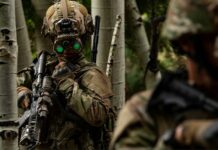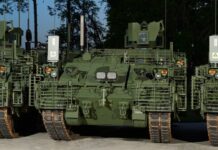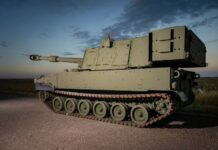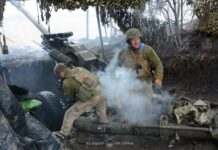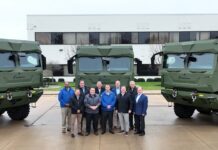After the US Army’s Ground Combat Vehicle programme was discontinued in 2017, the Next-Generation Combat Vehicle (NGCV) programme was established. It intends to replace the M2 BRADLEY which is nearing the end of its service life.
The US Army’s Optionally Manned Fighting Vehicle (OMFV) programme took a major step forward on 23 July 2021. On that date, the Army announced the selection of five competing firms to participate in the OMFV Concept Design Phase. The selected firms are American Rheinmetall Vehicle, BAE Systems, General Dynamics Land Systems (GDLS), Oshkosh Defense, and Point Blank Enterprises. The contract award for this phase has a total value of US$299.4M, or an average of US$60M per contractor.
The ultimate winner of the competition will go on to develop and build the OMFV as the replacement for the M2 BRADLEY Infantry Fighting Vehicle (IFV). The BRADLEY has received numerous upgrades since its fielding in 1982, and remains a powerful combat system. However, the Pentagon believes that it has reached the limits of its capabilities. The vehicle cannot accommodate additional technologies which are deemed decisive in order to survive and win on the future battlefield. An entirely new vehicle/weapon system is considered essential to maintaining the US Army’s operational advantage. According to Army statements, the service is seeking a “transformational” increase in warfighting capability rather than an “incremental” improvement in performance over the BRADLEY.
Capabilities and Characteristics
The BRADLEY replacement programme has suffered repeated setbacks over the past two decades. It took its current form in October 2018. The initial timeline and requirements released in March 2019 proved unrealistic, prompting the Army to reset the competition. The new programme guidance to industry was released in April 2020, superceding all previous directives to industry.
In contrast to the Army’s 2019 requirements, the rebooted competition set only minimal initial demands regarding features and attributes of the new combat vehicle. These are not formally designated as “requirements” but as desired “characteristics.” The nine objective characteristics defined in the December 2020 Request for Proposals are, in descending order of priority:
- Survivability: The OMFV shall be survivable against modern direct fire, indirect fire, and blast threats. The OMFV should reduce likelihood of detection by minimising thermal, visual, and acoustic signatures.
- Mobility: The OMFV must have mobility that can keep pace with the ABRAMS in a combined arms fight through rural and urban terrain.
- Growth: The OMFV must possess the growth margins and open architecture required for rapid upgrades and insertion of future technologies such as mission command systems, protection systems, and sensors.
- Lethality: The OMFV equipped platoons must defeat future near-peer soldiers, IFVs, helicopters, small UAVs and tanks as part of a Combined Arms Team in rural and urban terrain.
- Weight: The OMFV must traverse 80 per cent of Main Supply Routes (MSRs), national highways, and bridges in pacing threat countries, and reduce the cost of logistics and maintenance. Designs must allow for future growth in components and component weights without overall growth of vehicle weight through modularity and innovation.
- Logistics: The OMFV must reduce the logistical burden on Armoured Brigade Combat Teams and must be equipped with advanced diagnostic and prognostic capabilities. Advanced manufacturing and other innovative techniques should be included in the design that reduce the time and cost of vehicle repairs.
- Transportability: The OMFV must be worldwide deployable by standard inter- and intra-theatre sea, waterway, air, rail, and road modes of transportation.
- Manning: A platoon of OMFVs will transport 30 soldiers that dismount from the vehicles. Each OMFV vehicle will be crewed by no more than two soldiers who will be positioned in the hull. Squad members can perform crew duties prior to dismounting the OMFV but the vehicles must remain operational after dismounting. The OMFV should allow commanders to choose between manned or remote operation based on the tactical situation.
- Training: The OMFV should contain embedded training capabilities that are compatible with the Synthetic Training Environment (STE).
The lack of firm requirements allows industry to present concepts they considered realistic rather than tweak designs to the Army’s prescription. At the same time contractors are free to present unconventional concepts. The Army has pledged to consider integration of “relevant but immature” technologies into design concepts.
Priorities
The Pentagon’s one overarching directive is that the new vehicle must provide both greater occupant safety and combat power than the BRADLEY. OMFV is expected to accommodate new armour (including reactive armour and an APS or active protective system), offensive and defensive weapons potentially including directed energy weapons, and electronic systems (including advanced sensors, communications and networking, command and control systems, and electronic/cyber warfare capabilities). The Army expects that a combination of enhanced situational awareness (achieved through enhanced sensors and networking) and longer range precision weapons will enable the OMFV to identify and engage adversary combat vehicles before the opposing force detects the American formation.
As the programme designation makes very clear, the OMFV must provide the option of operating either with a human crew or remotely controlled by a dismounted crew. The crew will simultaneously be expected to operate external unmanned ground vehicles and UAVs.
“It is designed to operate with or without a crew and soldiers under armour based on the commander’s decision, while also controlling manoeuvre robotics and semi-autonomous systems,” reads a 27 July 2021 US Army press release.
One of the more challenging elements of the competition may be enabling a two-person crew to handle all of these tasks. Several contenders in the previous OMFV competition considered this impossible, but anticipated improvements in Artificial Intelligence could eventually enable the fusion of the vehicle commander and gunner functions.
Tactical networking – the ability to tie individual combat vehicles and even their crews and passengers into a common tactical awareness network – is increasingly important for the future battlefield. Modularity – and especially the ability to continually upgrade the vehicles with the latest enabling technologies over the course of its projected 22-year service life – remains another key characteristic of the OMFV.
For this reason, the Pentagon is developing an open architecture framework (Modular Open Systems Approach or MOSA) for the new IFV. This effort is running simultaneously with and parallel to the concept design phase. A consortium incorporating government, industry and academic participants was established in January 2021 to study and develop the open architecture concept.
“We’ve shared our initial set of standards for the modular open system architecture with industry,” said Brigadier General Glenn Dean, programme executive officer for Ground Combat Systems, during a July 2021 press briefing. “They are providing feedback to us, and we’re iterating on that. That will close midway in this concept design phase so that those final standards can be incorporated into the design concepts that the contractors are completing.”
Contenders
The Pentagon made a determined effort to reduce barriers to bids by foreign firms as well as small or non-traditional businesses. This is reflected in the down select for the concept design phase.
American Rheinmetall Vehicle
As in the previous OMFV go-around, Rheinmetall is partnering with US-based Raytheon to present an OMFV concept based on the German LYNX KF41. Additional partners include L3Harris and Textron. L3 will provide vehicle mission systems and cybersecurity; the firm’s modular open systems approach or MOSA will be incorporated into the OMFV design, simplifying upgrades as well as enabling cross-platform and cross-domain commonality of parts and subsystems. In February 2021, Rheinmetall added Allison as an additional partner to provide the vehicle with a “next generation electrified transmission.”
Back in 2019, the US Army had viewed the LYNX favourably. The Rheinmetall/Raytheon team was one of only two competitors initially downselected for the design phase. Positive attributes were the passenger capacity of eight soldiers (one more than the BRADLEY), the extensive modular armour system, and the LANCE 2.0 turret featuring a 35mm gun (more powerful than the BRADLEY’s 25mm cannon) as well as mission pods capable of deploying ATGMs, reconnaissance UAVs, loitering munitions and an electronic warfare package. Rheinmetall was ultimately dropped from the competition only because the firm failed to deliver the required test vehicle by the October 2019 deadline.
BAE Systems
BAE Systems is partnering with Elbit for the OMFV programme. The firm has provided few details about its plans, but did release a photo on social media which appears to depict the chassis of BAE’s Armoured Multi-Purpose Vehicle (AMPV) augmented with the Elbit UT30MKII unmanned turret. The AMPV (itself a derivative of the BRADLEY) was selected to replace the M113 armoured personnel carrier and is currently in low-rate production for the US Army.
At this point, it remains unclear whether the released image is actually representative of BAE’s new concept. The firm stresses the modularity of its future design, which would be capable of “rapid upgrades and technology refresh for quick insertion of new innovations or to counter emerging threats.”
General Dynamics Land Systems
During the previous OMFV competition, GDLS submitted the GRIFFIN III, itself a derivative of the British AJAX family of vehicles. For the current competition, the firm is taking a different approach. Rather than submitting a preliminary design concept, the company plans to provide a flexible “approach” to the design process that will explore a wide range of options, stated Ray Kiernan, OMFV programme director at GDLS.
“What we believe General Dynamics’ role to [be] is to apply our tools to help the Army understand where the optimal solution lies” within the wide range of technical possibilities, Kiernan said during an April 2021 Breaking Defense interview.
The firm has promised to deliver a “next generation” design that will constitute a major leap beyond the BRADLEY while leaving sufficient capacity for future upgrades. For the OMFV competition, GDLS has partnered with Applied Intuition, a firm specialising in autonomy and simulated vehicle development. GDLS corporate sister General Dynamics Mission Systems is also involved, bringing in vital experience in battle management systems, cybersecurity, and sensor integration.
Oshkosh Defense
US-based Oshkosh Defense is teaming with South Korea’s Hanwha Defense to present an OMFV concept based on the chassis of the Korean AS21 REDBACK IFV. The AS21 is itself a derivative of the K21 IFV which entered service with the ROK’s army in 2009. The K21 carries nine passengers plus a three-person crew; turret armament includes a 40mm gun and ATGMs. The REDBACK variant is armed with a 30mm main gun and ATGMs. It has a 3+8 person capacity, and is equipped with an advanced hydro-pneumatic suspension for superior cross-country performance. The situational awareness suite includes the IRON VISION system which allows the crew to effectively look through the hull; this would be particularly valuable while operating in close proximity with dismounted troops.
Hanwha entered the REDBACK in the Australian LAND 400 IFV procurement programme. The AS21 is one of two remaining contenders in the Australian competition, which will select the winner in 2022 (the other finalist is the KF41 LYNX). For the OMFV competition, Oshkosh plans to equip the AS21 chassis with a Rafael turret.
Point Blank Enterprises
The fifth competitor selected, Miami-based Point Blank Enterprises (PBE), is a dark horse. Unlike the other contenders, it is neither a major corporation nor an established vehicle design firm. Instead, PBE’s five decades of experience centre on development of body armour as well as lightweight armour for vehicles, aircraft and ships. PBE is partnering with Keshik Mobile Power Systems as well as other, yet to be named firms including “large, experienced defence companies and a large group of innovative small businesses with advanced technologies,” said PBE executive vice president Mark Edwards. The proposed concept will feature a distributed redundant hybrid electric drive train and a significant exportable electric power capacity. Keshick’s chief technology officer Frank Jones stated that the design will be built around a “modular and technology-agnostic open systems approach for power, information, and physical architectures.”
Parallel Programmes
OMFV is one of five armoured fighting vehicles currently being developed or to be developed for the US Army under the umbrella of the Next Generation Combat Vehicle (NGCV) programme. The other combat systems are:
- the AMPV to replace the M-113 Armoured Personnel Carrier
- Mobile Protected Firepower (MPF), a light tank to accompany Infantry Brigade Combat Teams
- Robotic Combat Vehicles (RCVs) which will be procured in three variants, Light, Medium, and Heavy
- the Decisive Lethality Platform (DLP), a notional future replacement for the M-1 ABRAMS Main Battle Tank (unlike the other vehicles, DLP is not currently an active programme).
Caveats
The Army’s Fiscal Year (FY) 2022 OMFV Research, Development, Test and Evaluation (RDT&E) budget request is US$225M. For the 2022-2026 timeframe, the projected OMFV budget is US$4.6Bn. The total programme cost, including research and development as well as procuring enough vehicles to replace the entire 3,800 M2 BRADLEY inventory, is estimated at US$46Bn.
The high price tag of the programme, coupled with the tight defence budgets, which are expected to prevail over the next few years, could lead to delays in implementation, or to cuts in performance and procurement goals.
“The Army budget will be squeezed and there will be intense competition for modernisation dollars,” warned CSIS scholar Marc Cancian in an April 2021 interview with Breaking Defense. “OMFV will need to compete with all [35] Army development programmes and is not mature enough to have developed a broad coalition in Congress.”
Cancian predicted that competing acquisition programmes such as long-range fires might be given budgetary priority, especially given the Biden administration’s current emphasis on countering China. While the Pentagon insists that the vehicle will be relevant to all geographic theatres of operation, including the Indo-Pacific area of responsibility, some critics of the programme have questioned whether the OMFV – or other heavy combat vehicles – are relevant for a conflict with China, given the distributed nature of the theatre. In this context, observers have noted that the Army has pushed “transportability” – which includes the ability to airlift the IFV – down to seventh place on the priority list. This could imply that the OMFV is being designed primarily for the European theatre, where lines of communications are shorter than in the Indo-Pacific, and where rail transport of military equipment is much more common.
Going Forward
The OMFV programme follows the Pentagon’s standard five-phase acquisition framework. All but the final phase will be conducted as full and open competitions. The current 15-month-long Concept Design Phase constitutes phase 2, and runs through the second quarter (Q2) of FY23; the competitors will develop purely digital designs, based on existing vehicle/weapon systems but optimised for future requirements. The models will be run through sophisticated simulations to determine what capabilities can be realistically expected. This phase will be marked by considerable back and forth dialogue between industry and the Army, said General Dean. “Some of that will include putting their concepts through modelling and simulation to demonstrate some of the operational value of some of those ideas. We, the government, will refine the requirements and specifications, feed that back out to the industry so they can update their concepts and repeat that cycle. There will be at least two cycles of requirements and specification updates back and forth with industry before the conclusion of the concept design phase at which point we expect the vendors to have highly refined concepts and be ready for actual design.” Based on analysis of these outcomes, the Army will finalize the firm technical and performance requirements which will guide the competition going forward.
During phase 3 (Q2-FY23 through Q4-FY24), the Army will downselect to three contenders who will develop detailed designs; phase 3 culminates in a Critical Design Review (CDR). During phase 4 (Q4-FY24 through Q4-FY27) each of the three contractors will build 12 prototype vehicles, which will be tested by the Army beginning in FY26; Phase 4 will culminate in the production contract award to a single vendor. Phase 5 (Q4-27 through Q4-FY30) will see Low Rate Initial Production of 388 vehicles, quality testing of the first operational vehicles, and the decision to proceed to Full Rate Production. The first operational battalion is expected to be fully equipped by 2029, with FRP commencing in Q2 of FY30.





